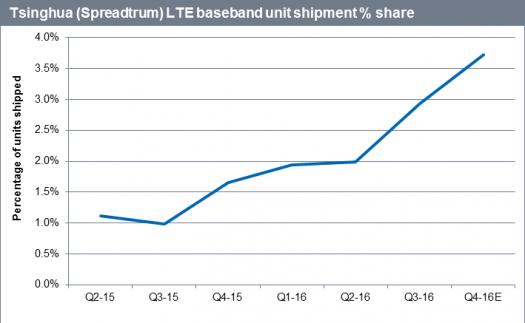Competition in the Chinese mobile SoC market is growing

At the Mobile World Congress there were many announcements relating to cellular modems and mobile SoC. Two major announcements came from Chinese smartphone OEM Xiaomi, and fabless semiconductor supplier Spreadtrum. While its announcement did not come from Barcelona, Xiaomi officially unveiled its first in-house designed mobile SoC, which will power its own Mi 5c smartphone. While in Barcelona, Spreadtrum announced a new 14nm SoC produced on Intel's Airmont architecture.
Xiaomi's announcement about its Surge 1 chipset comes after over two years of development through its Pinecone subsidiary with development beginning in late 2014. The specifications of the chip include an integrated five-mode Cat4 LTE modem supporting 23 frequency bands. Although the modem is five-mode it may not support WCDMA right away with that functionality coming via an OTA update after the release of the phone. Other specifications of the SoC include an eight core ARM Cortex A53 CPU with four cores clocked at 2.2GHz and four more clocked at 1.4GHz. The GPU is a four-core ARM Mali T860. Also in the SoC is a 32-bit DSP supporting high quality voice calls with 16kHz sampling and which also supports VoLTE; as well as a 14 bit dual ISP that enables increased light sensitivity and noise reduction algorithms. The Mi 5c itself sits at the lower end of the mid-range smartphone market as its prices start around $220 at release, which is slated for March 3, 2017.
In its announcement, Spreadtrum bills its new SC9861G-IA as a mid-range and high-end LTE SoC platform. The SoC was produced via Intel's custom foundry services. Intel announced Spreadtrum was designing on its 14nm foundry platform last fall. The octa-core 2GHz SoC has an integrated Cat7 modem capable of 300Mbps on the downlink and 100Mbps on the uplink. This is the second mobile SoC from Spreadtrum capable of Cat7 LTE, the company announced the previous generation SC9860 which was also capable of Cat7 during last year's Mobile World Congress. The GPU in the 9861G is the PowerVR GT7200 GPU as opposed to an ARM Mali T880MP4 which was used in the previous generation LTE chip, this marks another win for Imagination Technologies who displaced ARM's Mali on MediaTek's newly announced Helio X30 as well. The SC9860 was built on TSMC's 16nm FFC process. Overall this is the third LTE SoC from Spreadtrum since April 2015, when the SC9830 was announced. The SC9830 powered some non-flagship lower cost smartphones from market leader Samsung in 2016.
The Surge S1 and the SC9861G-IA are more examples of SoC that are best suited for mid-tier and below smartphones. The SoC will likely be competitive with the MediaTek Helio X30, Qualcomm Snapdragon 600 and 400 series products, Samsung Exynos 3 and 7 ModAP, and the Kirin 650 from HiSilicon. While Xiaomi is a newcomer to the SoC/LTE baseband market, Spreadtrum's own experience in the relatively early days of its LTE portfolio may prove how difficult it is to gain market share. Â [Of the afformentioned LTE basebands, only the MediaTek X30 and Qualcomm have CDMA capabilities] The company's LTE baseband market share has failed to exceed 4% since it entered the market in Q2-2015. Xiaomi will face a different situation as its SoC will be tied to the performance or market acceptance of its own phones in which it is used, starting with the Mi 5c.
For third party mobile SoC suppliers like Spreadtrum, relationships with large OEMs are critical as there are several examples of other companies who have entered and exited the market after failing to reach the necessary scale with their businesses to justify the expensive continual investment to compete in the market. Broadcom, Marvell, and nVidia are just three such examples of companies which for all intents and purposes decided to exit the mobile SoC market before reaching very high shipment volumes. If Xiaomi is successful with its Surge S1 SoC and Spreadtrum has a hit with its own SC9861, suppliers like MediaTek and Qualcomm will most likely be adversely affected. Both companies currently power phones from Xiaomi where a home-grown solution could limit future penetration and the product from Spreadtrum could compete strongly in China and other highly contested developing markets.

































